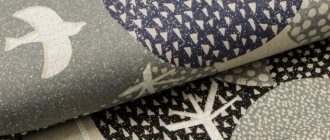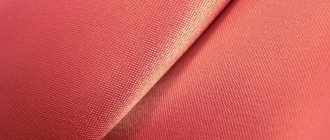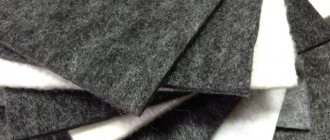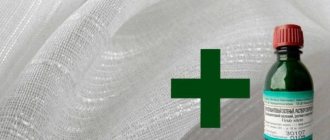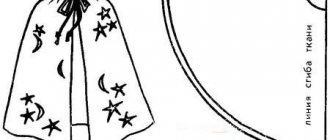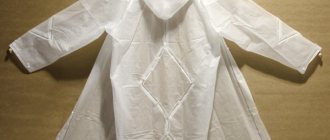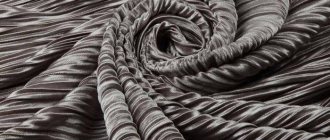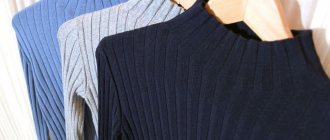Satin fabric is the name given to dense silk or semi-silk fabric, which has been known to mankind since ancient times. These fabrics are distinguished by a special, almost invisible satin weave. Canvases created in this way have a smooth front surface with a characteristic shine. This property of the satin is achieved due to the fact that the weft comes out through five or six warp threads to the front side. However, if we are talking about double-sided satin, then the weaving method is slightly different: the weft is hidden by two warp threads in between. Satin varies in composition, but historically this fabric was created from silk raw materials. Therefore, not everyone could afford to purchase this luxurious canvas. Beautiful iridescent fabric is great for sewing holiday items that will make you feel as impressive as possible.
History of the atlas
Satin fabric was first created more than 2000 years ago in China, in the port city of Quanzhou. But the word “atlas” itself is of Arabic origin and is translated as “smooth.” The nuances of producing this dense silk fabric were kept secret for a long time. Noble satin with its characteristic even shine remained the privilege of a narrow privileged group of people - clergy, emperors and representatives of the nobility. Even many years later, when the technology for creating the atlas became publicly available, the peculiarities of the extraction of silk raw materials did not allow it to be turned into a mass product. And these days, not everyone can afford to buy this durable silk fabric, but products made from satin look elegant and noble.
However, thanks to the invention of synthetics in the 20th century, it was possible to produce an atlas that almost everyone could afford. Of course, synthetic satin is significantly different from silk satin, but in terms of external parameters it is almost as good as its expensive and rarer predecessor.
Features of atlas production
The main feature of creating satin is the weave, satin or satin. Already from this name one can judge that the fabric received such a name precisely in honor of the weaving, and not the composition. Therefore, it is not one or another type of raw material that determines whether a fabric is classified as satin, but rather the type of weave. Yes, initially satin was mainly made from natural silk. This unique fabric comes at a high price. But today you can find budget blended options in which various synthetic and natural threads are added to silk. It can be either cotton or viscose, or polyester, nylon or acetate. There is also synthetic satin without the addition of silk at all.
The essence of satin weave is as follows: the warp threads are mostly released on the front side, overlapping the weft. It is this feature that influences the characteristic appearance of the atlas. One side of the fabric is shiny and smooth, and the back is also smooth, but matte.
Variety of atlas composition
In today's dynamic world, even centuries-old traditions are being transformed, so it is not surprising that satin made from natural silk is becoming less and less common. It is the cost of production and the high cost of raw materials that make such a canvas truly appreciated. In TISSURA you will find a variety of satin silk fabrics from leading European brands with which designers collaborate around the world. More information about the paintings can be found on our website, where additional information about the atlas is also published.
At the same time, manufacturers have learned to create high-quality satin from other materials; the most popular non-silk options are:
- cotton;
- acetate;
- viscose;
- polyester.
The raw materials for creating satin can be a variety of fabrics, both natural and synthetic or artificial. The most important thing that characterizes satin is the method of weaving, so you should pay attention not only to the desired composition, but also to the features of the texture of the fabric. It will be difficult for an unprofessional eye to determine the weaving method, so contact trusted companies to purchase real satin. At the TISSURA Fabric House, textile professionals will always advise you and help you choose not only the right fabric, but also harmonious accessories.
Length
As before, all satin dresses are considered fashionable - covering the ankle, reaching to the knee or reaching mid-thigh. Asymmetry is welcomed, which makes the image elegant.
Long to the floor
Laconic straight maxis highlight one aspect of the figure. A high slit on the side of the hem slightly opens the leg, creating dynamics when walking. Classics are also in trend. These can be closed styles with long sleeves, stand-up collars or frivolous outfits with an open back, bare shoulders and openwork inserts.
More details
10,500 ₽ IT SA PARTY DRESS Short dress
More details
11,000 ₽ NORA BARTH Midi dress
More details
6,700 ₽ Romanovich style Dress Romanovich style 1-1913 black
More details
43,000 ₽ BOTONDI COUTURE Midi dress
More details
RUB 70,000 ZIMMERMANN Midi dress
-15%
More details
RUR 1,129 SHEIN satin dress with floral print, slit and pleat
The “mermaid” model looks interesting. The skirt fits the upper thigh, expanding towards the bottom in the shape of a fishtail. The beauty of the silhouette is emphasized by the deep neckline and tight bodice. Embroidery with shining beads, rhinestones, and gilded threads is possible.
A short
A popular mini style is summer slip dresses made of thick satin. These are shortened straight “spaghetti” on narrow straps, often decorated with braid and lace.
Another trend is the A-line silhouette. A mid-thigh skirt is a classic A-line piece. Her companions:
- open shoulders;
- short sleeves (regular or frilled);
- round neck;
- V-neckline.
More details
RUR 30,700 N21 Midi dress
More details
RUB 93,750 SAINT LAURENT Short dress
-5%
More details
RUB 1,995 SHEIN Lucra one-shoulder bodycon dress with back zipper
More details
RUB 18,450 ALYSI Midi dress
More details
RUB 22,700 MICHAEL LO SORDO Midi dress
More details
RUR 22,000 CHRISTIAN PELLIZZARI Short dress
Midi lengths
The golden mean is fashionable knee-length outfits. These include cocktail dresses with different cuts. The corset top is combined with a bottom, which can be:
- lush, with multi-layered petticoats made of tulle or organza;
- massive, “balloon” type;
- slightly expanding, trapezoidal;
- strict, straight form.
Another option is clothing with a pleated skirt. It suits those with narrow hips. Also popular are midi styles in the “new look” style with a fitted bodice and sun-shaped hem.
More details
RUB 14,500 TOLANI Midi dress
More details
17,000 ₽ SLEEPING WITH JACQUES Long dress
More details
RUR 11,700 BEATRICE .b Midi dress
More details
1,370 ₽ SHEIN satin dress with frill and slit
More details
124,000 ₽ MARY KATRANTZOU Long dress
More details
5,800 ₽ VICOLO Long dress
Varieties of patterns
The design of the atlas is not limited by strict rules; it can be either patterned or plain. Patterns can be applied in different ways:
- Direct printing method. The design is transferred to the finished fabric using special inks and a printing block. It has better detail, a wider range of colors and additional effects than silkscreen printing.
- Jacquard. Wrinkle-resistant fabric with a pattern made of complex weaving. The image on the front side is identical to the back side, but the lines are mirrored. Such satin is usually considered a curtain fabric.
- Embroidery. It can be done either manually or using modern machines or machines.
- Embossing. This artistic finishing of the fabric is quite extraordinary. It involves creating a three-dimensional image on a surface. This method requires the use of an engraved thermal roller.
Satin dresses for special occasions
An outfit made of luxurious semi-silk fabric looks great in a formal setting. This is a must-have attribute for creating evening and cocktail looks, attending social events and official receptions.
Wedding
In the new fashion season, it is not at all necessary that the bride’s decoration be white and lush. Non-classic styles are allowed, including fitted and semi-fitted. The most popular models:
- A-line with long sleeves in lace fabric;
- tulip with open back and cut-out skirt;
- straight cut dress with chiffon cape and train;
- year with a corset bodice and flares from the knee.
More details
RUR 12,200 ODI ET AMO Short dress
More details
RUB 10,200 EQUIPMENT Midi dress
More details
7,000 ₽ PATRIZIA PEPE Short dress
More details
480 ₽ SHEIN Satin dress with straps
More details
RUR 1,470 SHEIN Zebra striped lace-up dress with belt
More details
RUB 13,300 MAJE Short dress
Prom Dresses
Dresses made from royal satin are never banal. Even if this fabric adds age to young beauties, you cannot deny it a festive mood. The trends of the season are tight-fitting models with puffed sleeves and luxurious A-line styles with a flared skirt. Classic variations with bright decor are also allowed:
- beads;
- colored embroidery;
- lace inserts;
- ruffles and flounces.
More details
RUR 9,150 VIVIENNE WESTWOOD ANGLOMANIA Midi dress
More details
11,500 ₽ LE SARTE PETTEGOLE Short dress
More details
RUR 8,650 JUCCA Midi dress
More details
7,300 ₽ TOY G. Short dress
More details
RUB 109,750 NAEEM KHAN Long dress
More details
RUB 6,950 ALICE + OLIVIA Midi dress
Types of atlas
- Crash. This type of crinkled fabric appeared in the 1980s. The main difference between cracked fabric is the long-lasting creases and folds that are produced using the press method. Easy to use as they do not require ironing.
- Crepe. Double-sided fabric with a slightly rough texture. Crepe-satin is made from tightly twisted threads, which is why it hardly wrinkles, has high strength and breathability.
- Satin. The fabric is made entirely from natural fibers of cotton and silk.
- Stretch. Such satin fabrics have stretch thanks to the elastane in their composition. Products made from elastic stretch satin fit exactly to your figure and hardly wrinkle.
- Duchess. Rigid, dense and at the same time light and delicate fabric, which has become famous as a premium fabric. Plain or embroidered milky or white duchess is often used for sewing wedding dresses.
- DuPont. Another type of exclusive silk fabric with high density and shiny surface.
- Taffeta. A luxurious fabric that originated in Persia, whose name in Persian literally translates to “woven cloth.” Taffeta is quite dense, but at the same time thin, holds its shape and can be draped.
- Antique. A fabric with a bright texture due to the alternation of thick and thin threads in the weft.
Current colors
Green, gold, pink, burgundy, black, blue, white, light blue, red.
More details
RUB 9,750 BROGGER Short dress
More details
RUB 23,000 AGLINI Midi dress
More details
RUR 2,330 SHEIN Asymmetrical satin dress with choker collar
More details
RUB 10,000 LA FEE MARABOUTEE Midi dress
More details
RUR 22,900 PAULE KA Short dress
More details
153,000 ₽ SAINT LAURENT Short dress
Combined dress models
Smooth glossy fabric looks good with other materials. Fashionable options:
- dress with satin and lace;
- satin and tulle;
- satin and guipure;
- satin and satin;
- satin and chiffon;
- satin and stretch;
- satin and silk;
- satin and velvet.
More details
RUB 7,550 HANAMI D OR Midi dress
More details
RUR 6,550 REPLAY Midi dress
More details
7,850 ₽ EUREKA by BABYLON Long dress
More details
RUB 78,950 WALES BONNER Midi dress
More details
RUB 27,000 IANUA Midi dress
More details
90,000 ₽ GIORGIO ARMANI Long dress
Application area
Luxurious satin has a wide range of applications:
- Smoothness and shine turns satin into a win-win option for elegant items for going out. It is chosen for sewing evening dresses, festive skirts, wedding dresses and suits.
- The distinctive characteristics of delicate satin make it possible to use it for sewing everyday clothes, for example, delicate blouses or men's shirts.
- Often the choice falls on satin when you want to sew a cute set of children's or women's underwear.
- A popular option for sewing beautiful linings suitable for coats or raincoats.
- Elegant accessories and jewelry are sewn from satin fabric: ties, hats, gloves... Satin is also used for the production of shoes, for example, pointe shoes.
As will be mentioned below, satin is used to create practical, but at the same time stylish home textiles.
Pros of fabric
The benefits of fabric certainly depend on the composition of the fabric. However, we can give a general list of advantages characteristic of the atlas as a whole.
- The fabric is hygroscopic. Satin is highly permeable to moisture and dries quickly enough. Drying a satin product is not at all difficult.
- Not electrified. Satin products do not need to be treated with an antistatic agent to prevent them from accumulating static electricity.
- Hypoallergenic. This applies to satin made from natural fibers, which is suitable for sensitive and children's skin. This is explained by the fact that satin fabric does not retain dust, so dust mites cannot grow there. However, “natural” is not always synonymous with “hypoallergenic”, since allergies can occur to a variety of fabrics. In the case of synthetic or artificial fabrics, the body’s reaction is also difficult to predict. But lyocell, which has a bactericidal effect, can be considered a completely reliable option.
- Durability, wear resistance and strength. Satin requires some care; only in this case will products made from this material look decent for as long as possible.
- Good drape, opacity. These properties make satin indispensable when it comes to making interior decor. An elegant solution for sewing curtains, bedspreads or bed linen.
Disadvantages of the material
- Before washing the product at high temperatures, familiarize yourself with the washing requirements and recommendations. If you increase the temperature of the water to critical levels, the atlas may lose its shape and shrink.
- The satin is quite loose. This disadvantage is especially obvious if the satin fabric is torn or cut.
- It can stretch, almost like knitwear, if we are talking about elastane in the composition, which can cause deformation of the product.
- The weight of the fabric can also be considered a disadvantage; some fabrics can be quite heavy.
Advantages and disadvantages
| pros | Minuses |
| Festive appearance. | Fabric made from natural or artificial fibers shrinks when exposed to high temperatures. |
| Strength exceeding crepe. | The ability to stretch leads to deformation of things, especially from acetate silk. |
| Elasticity | Difficulties during cutting and sewing (the fabric is slippery and heavy). |
| Opacity | Curtain satin has a lot of weight. In this regard, there is a need for special care |
| Drapability and pliability. | Flowability of the material |
| Keeps its shape | |
| Natural silk has healing properties (bed linen has a positive effect on health) | |
| Absorbs moisture | |
| Antistatic | |
| Hypoallergenic | |
| Durability | |
| Preservation of appearance | |
| Breathability | |
| Multifunctionality and versatility |
Based on customer reviews, we can conclude that everyone appreciates the beauty of the material. Not only clothes for adults are made from satin fabric, but also clothes for school performances. How not to tie a beautiful satin bow on a school ruler? Not a single girl at school will answer this question; this is an established tradition. Satin ribbon is used to make bows for hair and a red satin ribbon over the shoulder for graduates, which we tie for the last bell at school.
Care instructions
- Machine washable without spinning, in cool water. We recommend choosing a gentle cycle and delicate detergents, or it is better to wash the fabric by hand, soaking the item first.
- Do not rub or twist the satin during this process.
- Do not tumble dry. Proper drying is permissible not vertically, but horizontally on a towel.
- Some items require dry cleaning.
- You can iron from the inside out, but not at high temperature and through additional protective fabric.
- Storage tip: Use covers stored in dry, cool places.
Customer Reviews
Most of our clients agree on satin: its pleasant shine, smoothness and strength make this fabric truly competitive in the modern textile world. However, the problem of the high price of satin, even made from artificial fibers, is still relevant.
The catalog of the TISSURA Fabric House presents a wide selection of satin fabrics, both for dresses or blouses, and for suits or linings. Our consultants will be happy to help you calculate the required number of meters, select accessories, and answer all your questions, for example, about the possibility of purchasing in bulk.
